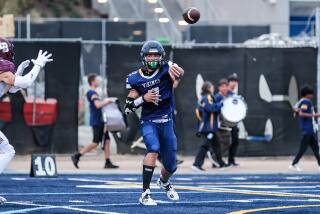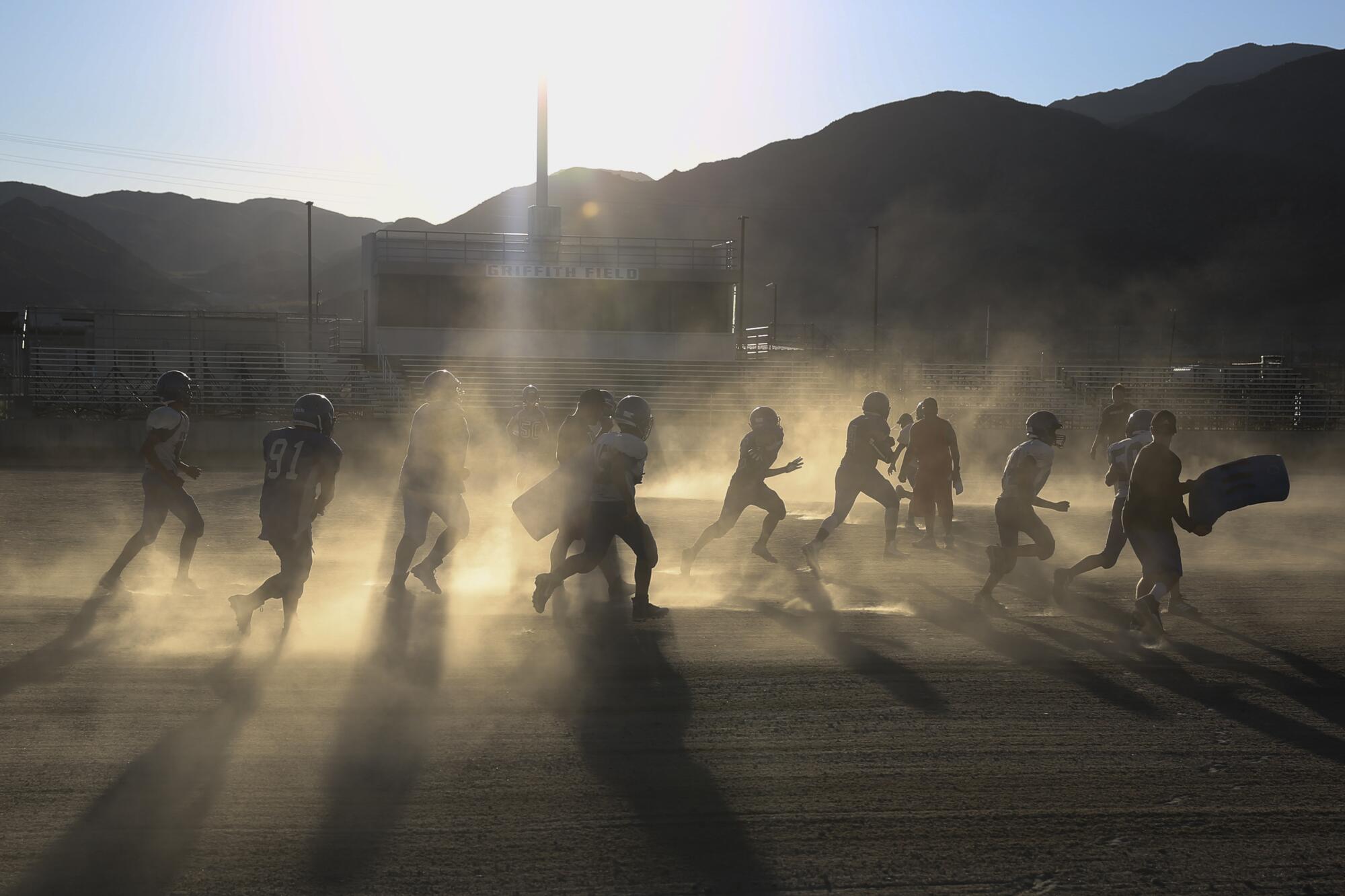
- Share via
TRONA, Calif. — Only nine kids show up for football practice on a brutal afternoon in August, the sun lingering stubbornly over this desert town, keeping the temperature in triple digits.
Tugging on shoulder pads and helmets in a cramped locker room, the players hold their chatter to a minimum, cleats ticking across the concrete floor as they head outside to a field that is barren because not a blade of grass grows at the edge of Death Valley. And it seems like the wind blows constantly here, pushing waves of dust across the landscape.
The coach, dressed in jeans and work boots, his arms heavily tattooed, calls for a few laps before stretching.
“How we feeling?” Richard Ancira barks. “Ready to work?”
Football has never been easy at Trona High.
At least in the old days the school fielded big squads, all those miners’ sons eager to prove themselves on Friday night. They forged a reputation for toughness, scratching out wins, even contending for an occasional championship.
That was before the local processing plant laid off hundreds of workers, leaving this remote community littered with abandoned homes, forcing the grocery and furniture store out of business. The Ridgecrest earthquakes last month scared off even more people.
Now the once-powerful Trona program, which downsized to eight-man football a while back, is scrambling to attract enough bodies for its fall schedule.
“Maybe they’re too lazy,” Bryce Johnson, the star running back, says of classmates who won’t play. “Or maybe they don’t want to get cut up on the dirt field.”
Practice begins near the far end zone, where goal posts lie face down, knocked over by the July temblor and still not fixed. There is an edge to Ancira’s voice as he goads his meager roster through hitting drills, knowing everyone must be ready to play on both sides of the ball.
Each tackle brings a burst of dust as players thud against bare earth and scattered rocks. Soon, they are spitting grit from their mouths and picking at bloody elbows. Two of them limp to the sideline, exhausted and cramping, but the workout continues.
“It’s hard,” the coach says later. “We’re trying to keep this thing alive.”
::

Highway 14 stretches north from Los Angeles into the high desert, leading to a narrower road that veers eastward through rock-girded hills, down into Searles Valley where the air often smells of sulfur and the terrain is ruggedly beautiful in an alien way.
A “Star Trek” movie was filmed around here. Conspiracy theorists have suggested NASA used the isolated region to fake a moon landing.
Much of the valley floor is covered by a dry lake bed from which borax and soda ash can be extracted, an abundance that gave birth to Trona in the early 1900s. The quintessential company town, named after an indigenous mineral, sprang up in increments of large plants and modest homes.
There was an ancillary benefit to the mining industry — migrants from Texas and Oklahoma came looking for jobs, bringing with them a love of football.
Trona High won an unofficial CIF Southern Section title in 1948, playing an unsanctioned, six-man version of the game. The victories continued as the population grew — on its way to 6,000 — and the team graduated to a standard 11-man format.
Through the 1950s and ’60s, each Friday in fall brought a reason to celebrate. When the plant shifts changed in late afternoon, workers gathered along the main road to watch players and the marching band go by like some kind of parade.
“Then everyone went home to eat dinner right away,” recalls Tim Burrell, an offensive and defensive end from that era. “If you didn’t get to the stadium early, you didn’t get a place to sit.”
Though the school chose Tornadoes as its official mascot, people eventually started referring to the team as the Sandmen. The Trona High stadium with its desolate field and modest bleachers also got a nickname: the Pit.
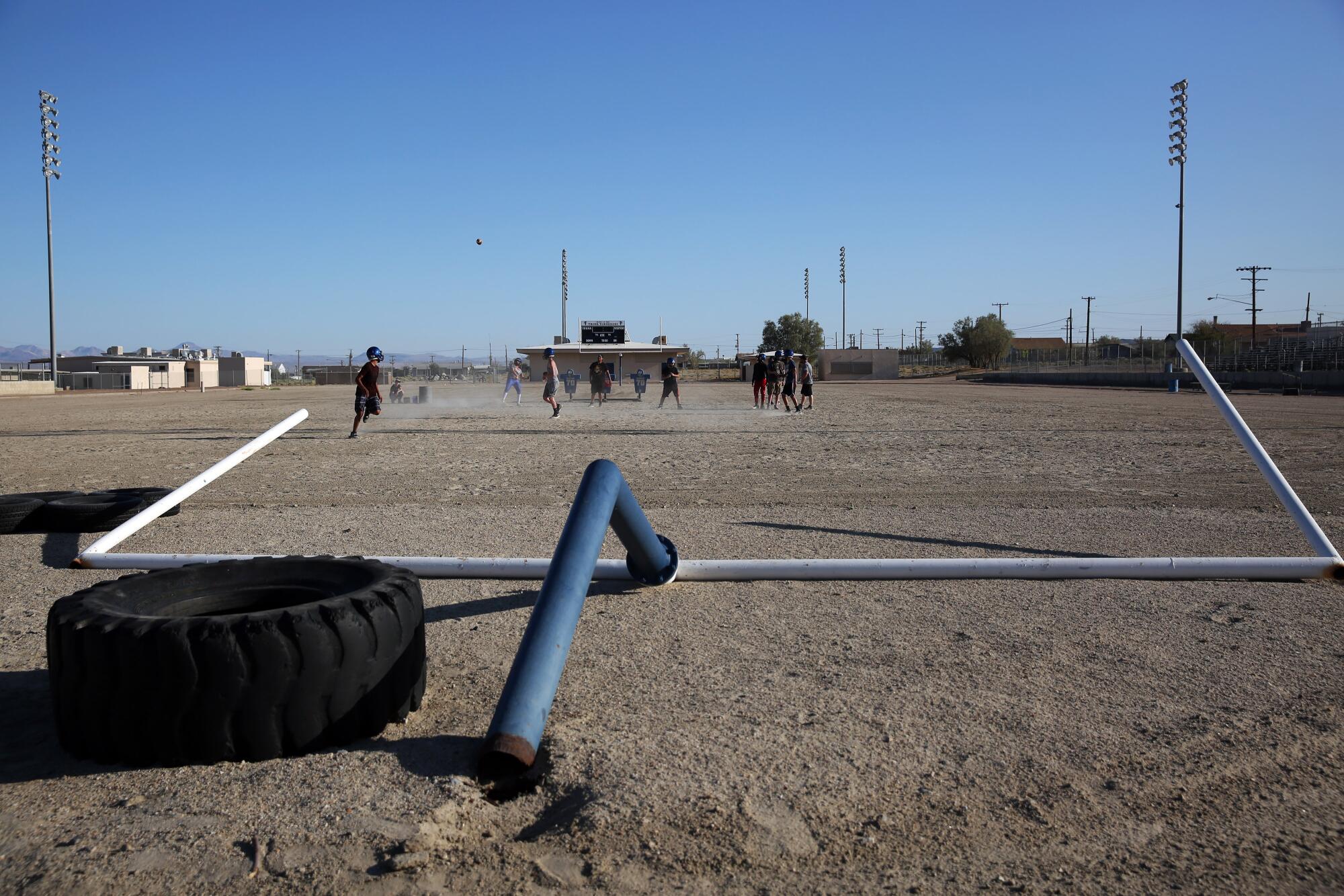
Dirt became a tradition that stuck, even after the advent of artificial turf.
On game nights, the groundskeeper marked yard lines with a white powder — sodium sulfate — donated by the plant. The surface was watered and rolled to a firm consistency that inevitably softened by halftime, driving opponents crazy, the mush neutralizing any advantage of speed or talent.
Tronans like to boast that no other U.S. high school plays on dirt. Ancira says: “It’s all about being tough.”
The Sandmen were particularly strong in 1957 and again in 1965, when they reached the Southern Section lower-division championship game, falling to Needles.
It was a big deal in a town of simple diversions, a place where kids roamed the hills after school, collecting rocks or trapping scorpions in a glass jar. Movies showed after dark at an outdoor cinema with steam lines running under the benches to keep everyone warm in winter.
“Football was the entertainment,” Burrell says. “Everybody longed to be part of it.”
The program’s struggles began in the early 1980s, locals say, as a bitter strike hit the plant and ownership laid off a third of the workforce.
Lots of families moved a half-hour down the road to Ridgecrest, where the China Lake naval station was attracting more people, stores and amenities. Trona began shrinking to its current population of fewer than 2,000.
It seems like two of every three homes stand empty, their windows busted out and roofs sagging. Some have burned down, leaving only piles of charred timber.
Ancira grew up and played here before returning as coach. The 45-year-old is correct when he says: “If you Google the most bleak places in America, Trona makes the list.”
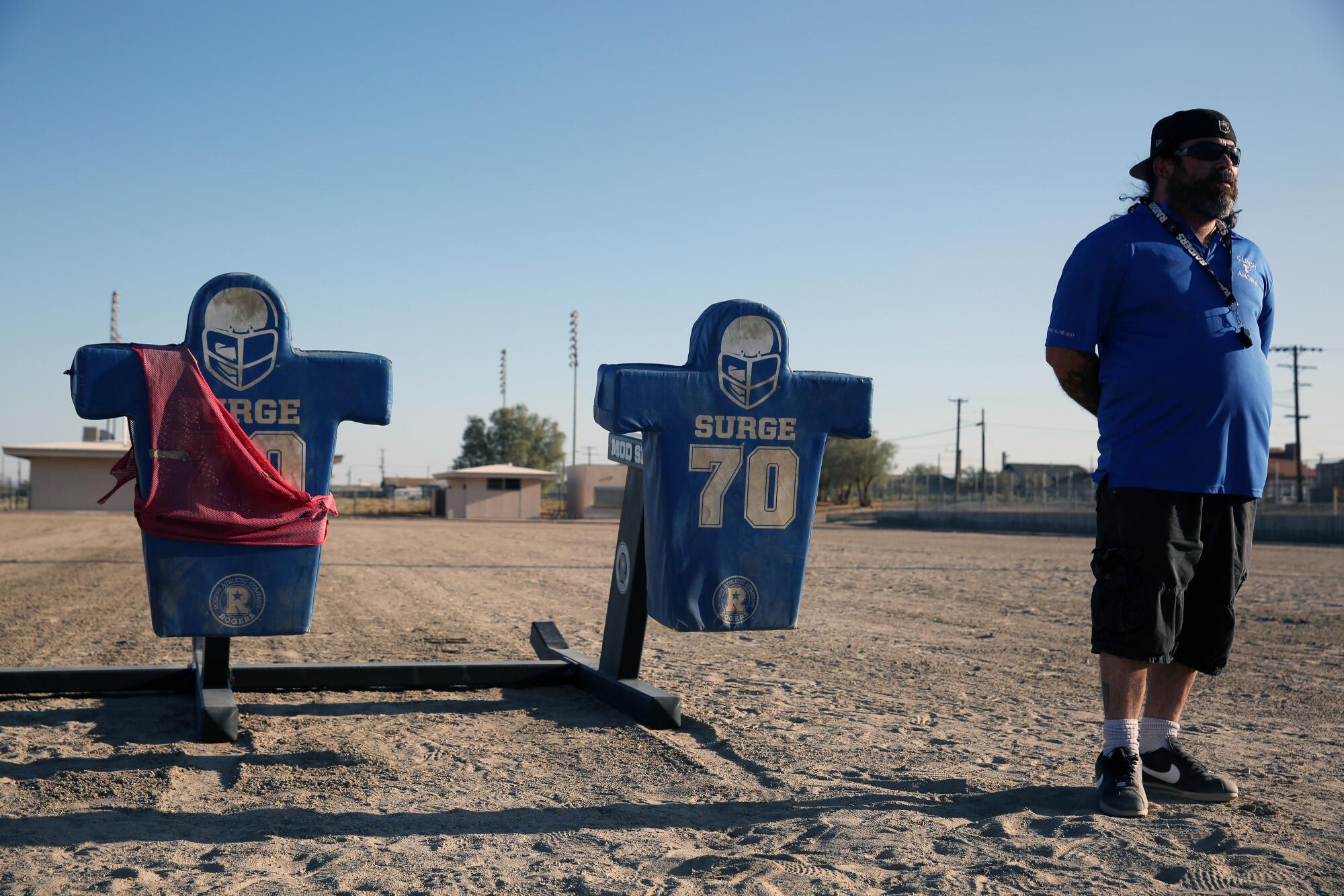
Dwindling enrollment — not so many boys to choose from — prompted the school board to consider eight-man football as far back as the late 1990s. Angry residents resisted but, after the team forfeited several games for lack of players in 2002, the change was made.
Trona High now has about 80 students. A former player who serves on the board suggests that numbers are only part of the problem.
“A lot of it is our society,” Skylar McCullar says. “There are too many kids staying inside, playing video games and all that.”
Still, McCullar and others believe that keeping the football program around, even in an abridged form, is important.
The magnitude 6.4 foreshock that hit on the Fourth of July, followed by a 7.1 earthquake the next day, damaged homes and roads, disrupting the power and water supply. Nerves have remained frayed with more than 80,000 aftershocks since then.
During a recent practice, the cellphone in Ancira’s pocket beeps from an early warning app. He says of the aftershocks: “You can still feel them every day. I know it has affected some of the players.”
Fissures zigzag through the ground around the stadium. Small chunks of concrete have broken loose in the campus’ main quad, and students will have to attend fall classes at the local elementary school, which suffered less damage, until work crews finish with repairs.
McCullar sees Friday nights as a welcome distraction.
“Football is a little normalcy,” he says. “We need that.”
::
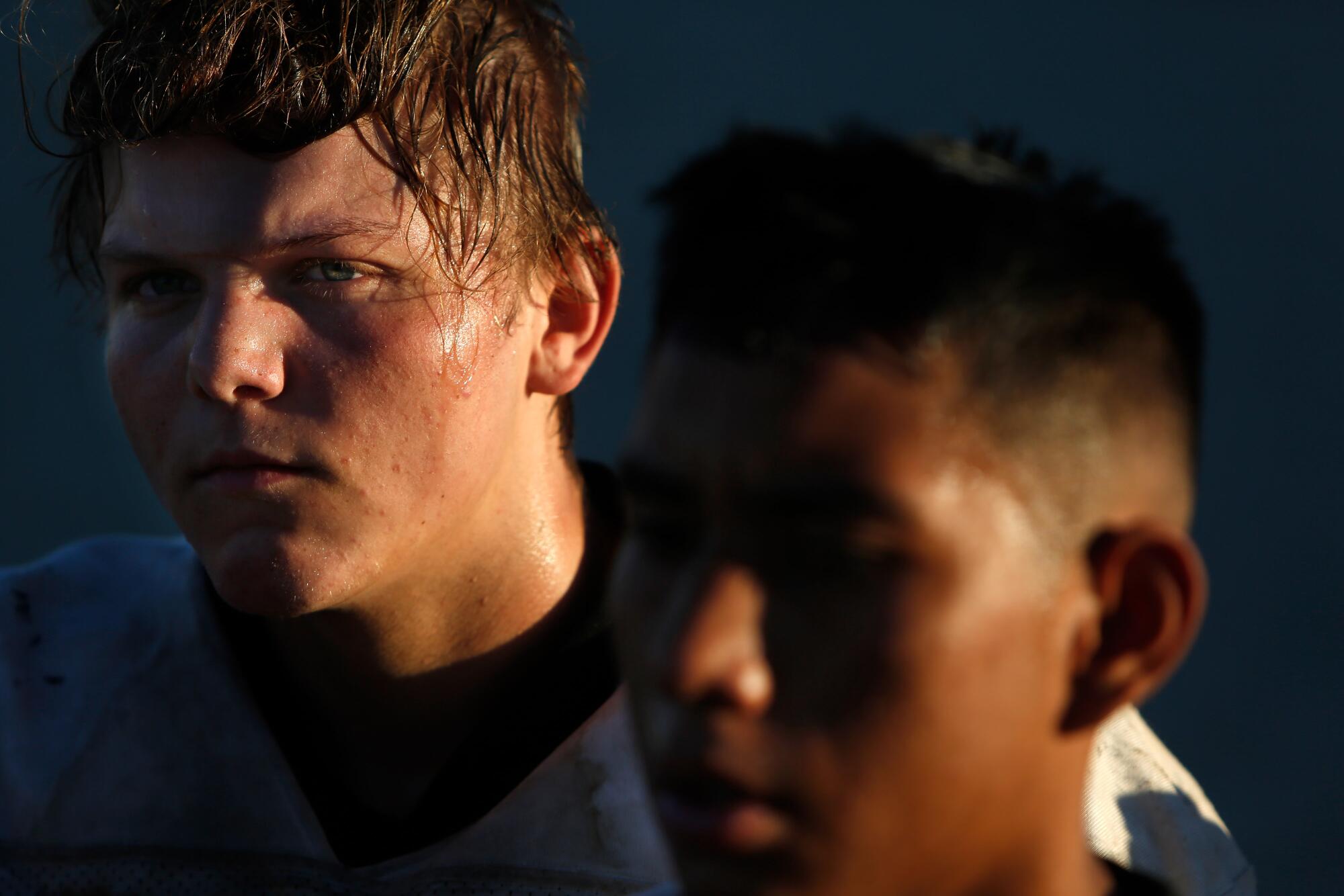
The whistle blows and Johnson takes off, head down, legs pumping.
The senior running back is a bit undersized but possesses the strong build and quick wits of a natural-born athlete. He knows that, whether in drills or games, a straight-ahead style works best on his home field. Also, when a defender moves in, he knows to clamp his lips shut.
“It’s something you learn,” he says. “Otherwise, you’ll get a mouthful of dirt.”
There are lots of tricks to playing at Trona. Ancira sounds almost pleased when he talks about going full-contact in summer camp, getting his team good and “scabbed up” before the season begins.
“Just take some dirt and rub it on,” receiver Ivan Canty says of the scraped elbows. “That stops the bleeding.”
Column One
Column One is a showcase for compelling storytelling from the Los Angeles Times.
The Sandmen will need every advantage they can muster this fall, the schedule filled with opponents such as Mammoth, Desert Christian and Mojave. Ancira says some schools will bring more cheerleaders than he has players.
Scribbling a list of names on paper, he ponders his limited roster. Johnson will be a standout, as will Canty, who is built long and lean. Jaylen Franklin possesses unusual quickness for someone weighing 280 pounds.
A few more kids might be persuaded to join. In early August, some are still on vacation or working summer jobs; the coach is hoping for a roster of 15 by the time Trona plays its opener at Alpaugh High on Saturday.
“Even if we get that, we’ll lose some,” he says. “They’ll get hurt or they’ll quit. It’s a weeding-out process.”
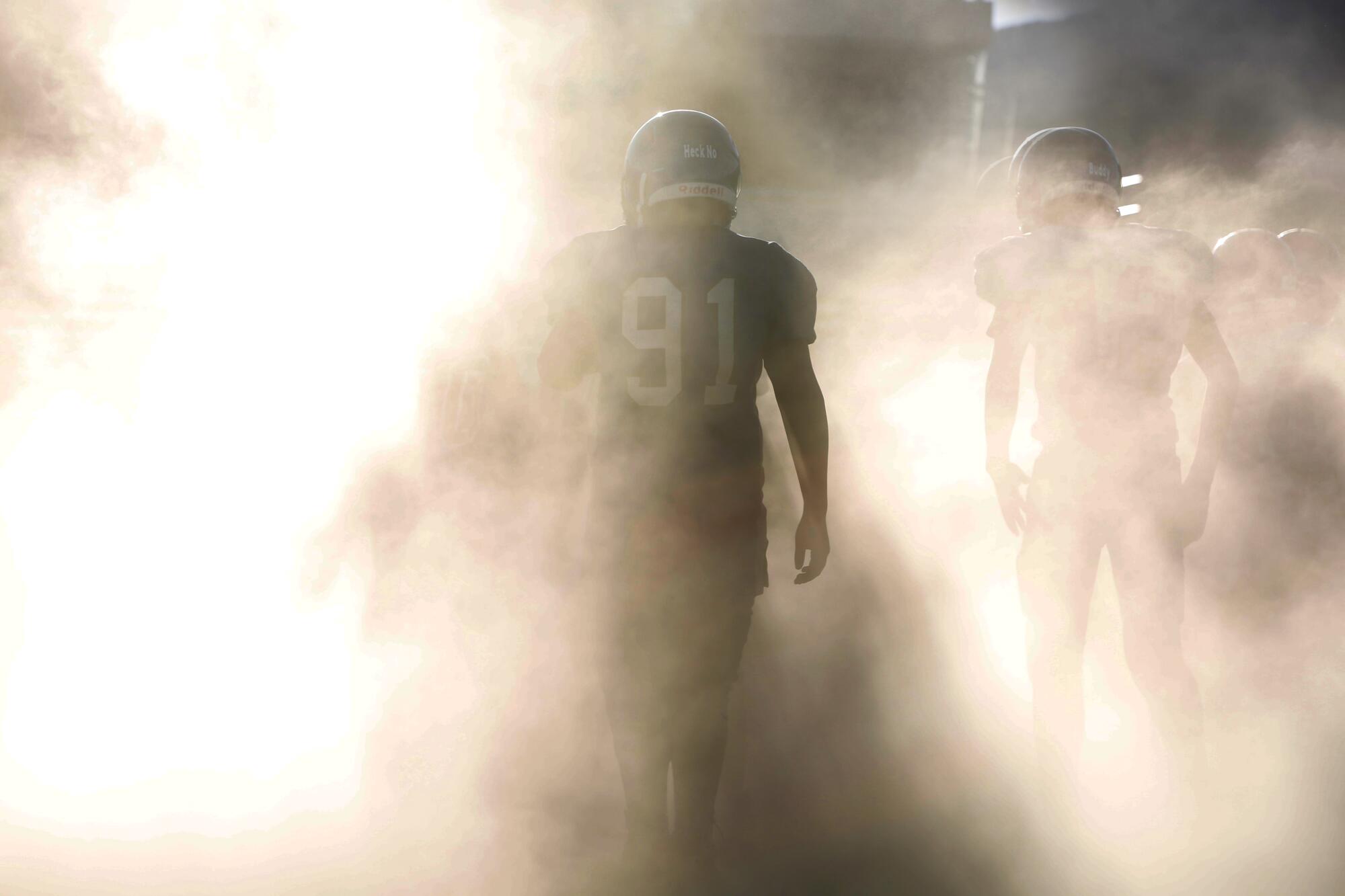
More than a year has passed since Ancira took over the program while keeping his job as a maintenance worker at the nearby military base. His looks don’t exactly scream football coach, not with all those tattoos, that long hair and beard.
Wins have never been a priority.
“I love this community,” Ancira recalls telling administrators when he interviewed for the position. “We’re going to be turning these kids loose as adults pretty soon, and I want to make sure they have some responsibility and integrity.”
Rules matter to him — even pregame jumping jacks must be performed with exact movement, the numbers yelled loudly. Commitment is just as vital.
His players understand; they have heard talk about past winning teams, so they know what football means to the town. When practice winds down and Ancira asks if anyone wants to put in extra work, several of them quickly raise their hands.
The coach’s version of the famed Oklahoma drill has two kids lying on their backs, head-to-head, then jumping up and spinning around to smack each other full-force. It is a grueling routine, punctuated by the plastic clack of pads, and it leaves everyone shaking the dust from their uniforms as they leave the stadium.
“Playing here gives you thick skin,” Johnson says.
A sign on the gym door reads “Restricted Use” because part of the building is still damaged and off-limits. The locker room is safe, but the plumbing was fractured by the earthquake.
That means no running water. It means no showers. The players, still sweating and grimy, change into their street clothes and head home.
More to Read
Go beyond the scoreboard
Get the latest on L.A.'s teams in the daily Sports Report newsletter.
You may occasionally receive promotional content from the Los Angeles Times.

